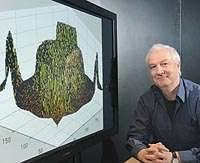Neural modeling helps expose epilepsy's triggers

(PhysOrg.com) -- A brain scan of a person experiencing an epileptic seizure looks like the Great Plains during an early evening in midsummer. Fierce electrical storms pop up seemingly at random, proliferate over large areas and subside almost as quickly as they arose.
The complex interplay of microscopic physical and biological effects that govern the strange dynamics of epileptic seizures has long remained a mystery to scientists and doctors who seek to comprehend and treat this common and often life-threatening condition.
In order to enrich their understanding of why seizures occur and propagate, scientists at the U.S. Department of Energy's Argonne National Laboratory have created a life-like model of small areas in the brain using state-of-the-art high-performance computers. The conclusions that Argonne researchers draw from these models directly impact their collaborations with clinical and laboratory neuroscience researchers at the University of Chicago.
For many years, computer scientists have used complex models known as "neural networks" to model brain activity. These simulations use many separate data structures to represent individual brain cells, or neurons. Because each neuron can receive information - in the form of an electrical pulse - from thousands to tens of thousands of other neurons, scientists need an extremely powerful computer to handle all of the model's interconnections, said Argonne computer scientist Mark Hereld. But, he added, the brain's complexity prevents any current model from accurately representing more than small sections of it.
"The big question is,'just how large a model do you have to build in order to understand a condition like epilepsy?'" Hereld said. "If neural networks behaved like other physical phenomena - like weather, blood flow or supernovas, for instance - then we could model separate small spatial areas and have them communicate just with their immediate neighbors. But it's not that simple - the connection between neurons is far more helter-skelter, so the behavior we're trying to explain takes time to propagate throughout the system."
Using standard techniques like electroencephalography (EEG), doctors and scientists can get a sense of large-scale dynamics that involve millions of neurons, while other techniques enable researchers to see the interplay between just a few neurons. However, scientists lack the experimental capability of seeing how the smallest-scale behaviors translate to the larger system, said Wim van Drongelen, who heads the pediatric epilepsy center at the University of Chicago Hospitals.
"Looking at an EEG is like listening to a choir from the back of a cathedral - you can hear the piece as a whole but can't pick out individual voices," Drongelen said. " By contrast, an electrophysiologist has a microphone in front of the tenors, but he misses hearing the altos and sopranos. Neural network models give us a way to piece things together to understand how epileptic behavior translates from the action of just a few neurons to a behavior affecting the entire brain, which contains hundreds of billions of neurons."
Older neural networks treated each neuron as a fixed entity that could exist only in one of two states: firing or inactive. The more sophisticated models devised by Hereld and his colleagues treat each neuron as a pathway unto itself; they trace the route of an electrical signal from the fibrous dendrites into the cell body and out through the axon to other neurons. Rather than conceiving of each neuron as a single entity, Hereld's model treats it as a data chain, where each link represents a different physical site on the cell.
Hereld's model also offers another advantage over older neural networks. The "neurons" in the network are classified into one of six different groups, depending on their actual neurophysical role. The model also sorts the "wiring" of axons and dendrites that connects the cell bodies of different neurons into 32 separate types, each with different electrical and chemical properties.
The model has already produced findings that call into question some commonly held assumptions about how epileptic seizures arise. According to Hereld, conventional wisdom has long linked the onset of seizures to over-excitation of the brain's network. However, he said, the Argonne model produces more epileptiform activity when the neurons have a lower excitation strength.
According to Hereld, models of neural networks provide a glimpse into epilepsy that complements information obtainable through clinical or laboratory studies. "There are some questions that simply can't be answered by examining a live patient or looking at a small piece of brain tissue in the lab," Hereld said. "Computing offers the possibility of changing any parameter to answer highly targeted questions about the fundamental causes of seizures."
Provided by Argonne National Laboratory




















